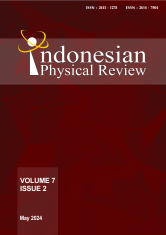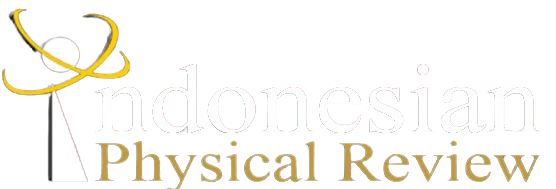DETERMINING THE RELATIONSHIP BETWEEN TEMPERATURE AND TUNING FORK FREQUENCY CHANGES WITH POLYNOMIAL REGRESSION MODELLING
DOI:
10.29303/ipr.v7i2.263Downloads
Abstract
A tuning fork is a unique tool made of metal and shaped like the letter U, with one handle. Tuning forks can produce specific frequencies; usually, the value is written on the handle. This study aims to investigate the relationship between temperature and changes in tuning fork frequency and model it using polynomial regression. This research uses laboratory experiments with tuning forks with 341.3 Hz, 426.5 Hz, and 512 Hz frequencies. The temperature on the tuning fork varies from 30C to 220C with a difference of 10C. From the results of the study adjusted R-Square values sequentially 0.94745, 0.99565, and 0.97721, which stated the relationship between temperature and frequency changes. The Adjusted R-Square value close to 1 means that changes in temperature on the tuning fork greatly influence changes in the frequency produced by the tuning fork, and the polynomial regression model used is very suitable.Keywords:
Frequency; Tuning fork; Polynomial regression; Adj. R-Square, AudacityReferences
D. W. Schindel, D. A. Hutchins, and S. T. Smith, ‘A study of materials at high temperature using miniaturized resonant tuning forks and noncontact capacitance transducers’, J. Acoust. Soc. Am., vol. 102, no. 3, pp. 1296–1309, 1997, doi: 10.1121/1.420095.
M. Köhring, S. Böttger, U. Willer, and W. Schade, ‘Temperature effects in tuning fork enhanced interferometric photoacoustic spectroscopy’, Opt. Express J., vol. 21, no. 18, pp. 20911–20922, 2013, doi: 10.1364/oe.21.020911.
N. Dagar et al., ‘Frequencies of Triangular Plate With Two-Dimensional Parabolic Thickness Under Temperature Field’, J. Theor. Appl. Mech., vol. 52, pp. 305–316, 2022, doi: 10.55787/jtams.22.52.4.305.
J. Ma, J. Xu, J. Duan, and H. Xu, ‘Micro-temperature sensor based on quartz tuning fork resonator’, J. Appl. Sci. Eng. Technol., vol. 5, no. 4, pp. 1232–1237, 2013, doi: 10.19026/rjaset.5.4855.
Q. Wu, S. Gao, L. Jin, S. Guo, Z. Yin, and H. Fu, ‘A Frequency-Adjustable Tuning Fork Electromagnetic Energy Harvester’, J. Mater., vol. 15, no. 2108, pp. 1–18, 2022, doi: 10.3390/ma15062108.
T. D. Rossing, D. A. Russell, and D. E. Brown, ‘On the acoustics of tuning forks’, American Journal of Physics, vol. 60, no. 7. pp. 620–626, 1992. doi: 10.1119/1.17116.
Q. Pan, H. Jiang, Y. Li, Q. Wang, B. Huang, and R. Li, ‘Resonant Type Piezoelectric Pump Driven at the Power Frequency Using a Tuning Fork Vibrator’, Int. J. Acoust. Vib., vol. 25, no. 4, pp. 549–555, 2020, doi: 10.20855/ijav.2020.25.41709.
J. Huo and X. Yang, ‘Research on quasi-geoid fitting method based on EGM2008 model and quadratic polynomial fitting function’, J. Phys. Conf. Ser., pp. 1–5, 2021, doi: 10.1088/1742-6596/2035/1/012012.
Y. Gu and J. Dai, ‘Study on Preparation of C4 Olefin by Ethanol Coupling Based on Polynomial Fitting Analysis’, Acad. J. Eng. Technol. Sci., vol. 4, no. 7, pp. 57–61, 2021, doi: 10.25236/ajets.2021.040710.
D. I. Oladapo, E. Y. Ametepey, V. O. Akinsola, F. A. Amao, and S. B. Atoyebi, ‘An Alternative Estimator for the Estimation of Polynomial Regression Model (PRM)’, J. Adv. Math. Comput. Sci., vol. 38, no. 7, pp. 1–11, 2023, doi: 10.9734/jamcs/2023/v38i71768.
H.-E. Song, Y.-H. Kang, S.-K. Yang, and Y. chull Ahn, ‘Prediction of pressure drop from multivariate polynomial regression for membrane-based air-to-air energy recovery ventilator cores’, Sci. Technol. Built Environ. J., vol. 29, no. 3, pp. 339–346, 2023, doi: 10.1080/23744731.2023.2172284.
T. Saksono and M. A. Fulazzaky, ‘Predicting the accurate period of true dawn using a third-degree polynomial model’, NRIAG J. Astron. Geophys., vol. 9, no. 1, pp. 238–244, 2020, doi: 10.1080/20909977.2020.1738106.
H. Alahmer, A. Alahmer, R. Alkhazaleh, and M. I. Al-Amayreh, ‘Modeling, polynomial regression, and artificial bee colony optimization of SI engine performance improvement powered by acetone–gasoline fuel blends’, Energy Reports J., vol. 9, pp. 55–64, 2023, doi: 10.1016/j.egyr.2022.12.102.
L. Cantone and A. Ottati, ‘Modelling of Friction Coefficient for Shoes Type LL By Means of Polynomial Fitting’, Open Transp. J., vol. 12, pp. 114–127, 2018, doi: 10.2174/18744478018120100114.
J.-H. Do, S.-W. Kang, and S. B. Choi, ‘The effect of perceived supervisor–subordinate congruence in honesty on emotional exhaustion: A polynomial regression analysis’, Int. J. Environ. Res. Public Health, vol. 18, no. 17, pp. 1–16, 2021, doi: 10.3390/ijerph18179420.
M. Ekum and A. Ogunsanya, ‘Application of Hierarchical Polynomial Regression Models to Predict Transmission of COVID-19 at Global Level’, Int. J. Clin. Biostat. Biometrics, vol. 6, no. 1, pp. 1–18, 2020, doi: 10.23937/2469-5831/1510027.
A. L. G. Wah, N. Muda, and A. R. Othman, ‘Testing Personal Orientations - Organizational Climate Fit using Polynomial Regressions, Response Surface, and Bootstrapping’, Sains Malaysiana J., vol. 48, no. 2, pp. 473–485, 2019, doi: 10.17576/jsm-2019-4802-25.
X. Wan, ‘The effect of regularization coefficient on polynomial regression’, J. Phys., vol. 1213, pp. 1–4, 2019, doi: 10.1088/1742-6596/1213/4/042054.
J. Yu et al., ‘A confidence interval-based process optimization method using second-order polynomial regression analysis’, Process. J., vol. 8, no. 10, pp. 1–19, 2020, doi: 10.3390/PR8101206.
C. Zhou, ‘House price prediction using polynomial regression with Particle Swarm Optimization’, J. Phys., vol. 1802, no. 3, pp. 1–6, 2021, doi: 10.1088/1742-6596/1802/3/032034.
S. Nakanishi et al., ‘Association Between Severity of Diabetic Neuropathy and Success in Weight Loss During Hospitalization Among Japanese Patients with Type 2 Diabetes: A Retrospective Observational Study’, Diabetes, Metab. Syndr. Obes. J., vol. 13, pp. 1669–1676, 2020, doi: 10.2147/DMSO.S252673.
J. B. Wachtman, W. E. Tefft, D. G. Lam, and C. S. Apstein, ‘Exponential Temperature Dependence of Young’s Modulus for Several Oxides’, Phys. Rev. J., vol. 122, no. 6, pp. 1754–1759, 1961, doi: 10.1103/PhysRev.122.1754.
W. Li et al., ‘Temperature-dependent elastic modulus model for metallic bulk materials’, J. Pre-proof, vol. 139, pp. 1–26, 2019, doi: 10.1016/j.mechmat.2019.103194.
B. Tatira, ‘Mathematics Education Students’ Understanding of Binomial Series Expansion Based on the APOS Theory’, Eurasia J. Math. Sci. Technol. Educ., vol. 17, no. 12, pp. 1–13, 2021, doi: 10.29333/EJMSTE/11287.
K. Youngmee and R. Sangwook, ‘The Origin of Newton’s Generalized Binomial Theorem’, J. Hist. Math., vol. 27, no. 2, pp. 127–138, 2014, doi: 10.14477/jhm.2014.27.2.127.
S. Gergün, B. Silindir, and A. Yantir, ‘Power function and binomial series on T(q,h)’, Appl. Math. Sci. Eng. J., vol. 31, no. 1, pp. 1–18, 2023, doi: 10.1080/27690911.2023.2168657.
V. R. Hlokoe, K. Mokoena, and T. L. Tyasi, ‘Using multivariate adaptive regression splines and classification and regression tree data mining algorithms to predict body weight of Nguni cows’, J. Appl. Anim. Res., vol. 50, no. 1, pp. 534–539, 2022, doi: 10.1080/09712119.2022.2110498.
K. Osinowo et al., ‘Resilient and Accelerated Scale-Up of Subcutaneously Administered Depot–Medroxyprogesterone Acetate in Nigeria (RASuDiN): A Mid-Line Study in COVID-19 Era’, Open Access J. Contracept., vol. Volume 12, pp. 187–199, 2021, doi: 10.2147/oajc.s326106.
O. M. Akinsola et al., ‘Comparison of five mathematical models that describe growth in tropically adapted dual-purpose breeds of chicken’, J. Appl. Anim. Res., vol. 49, no. 1, pp. 158–166, 2021, doi: 10.1080/09712119.2021.1915792.
V. Govindaraj and B. Arunadevi, ‘Machine Learning Based Power Estimation for CMOS VLSI Circuits’, Appl. Artif. Intell. J., vol. 35, no. 13, pp. 1043–1055, 2021, doi: 10.1080/08839514.2021.1966885.
Y. Wen et al., ‘Comparison of nine growth curve models to describe growth of partridges(Alectoris chukar)’, J. Appl. Anim. Res., vol. 47, no. 1, pp. 195–200, 2019, doi: 10.1080/09712119.2019.1599900.
P. N. Vasantha, A. Abirami, N. Gayathri, and G. Vijayalakshmi, ‘Playing Sound Files in Labview Using Audacity Toolkit’, Int. J. Res. Eng. Technol., vol. 04, no. 02, pp. 456–458, 2015, doi: 10.15623/ijret.2015.0402062.
A. Hujatulatif, J. Jumadi, H. Kuswanto, and A. Z. Ilma, ‘Analyzing and Comparing Frequency of the Birds Sound Spectrum using Audacity Software in Practicum Activity’, J. Penelit. Pendidik. IPA, vol. 8, no. 6, pp. 2586–2592, 2022, doi: 10.29303/jppipa.v8i6.1697.
A. Azalia, D. Ramadhanti, Hestiana, and H. Kuswanto, ‘Audacity Software Analysis In Analyzing The Frequency And Character Of The Sound Spectrum’, J. Penelit. Pendidik. IPA, vol. 8, no. 1, pp. 177–182, 2022, doi: 10.29303/jppipa.v8i1.913.
E. Aalto, K. Saaristo-Helin, and S. Stolt, ‘Auditory Word Recognition Ability in Babble Noise and Phonological Development in Children at 3;6 Years of Age’, Lang. Learn. Dev. J., vol. 19, no. 2, pp. 230–247, 2023, doi: 10.1080/15475441.2022.2060833.
J. He, A. S. Meyer, and L. Brehm, ‘Concurrent listening affects speech planning and fluency: the roles of representational similarity and capacity limitation’, Lang. Cogn. Neurosci. J., vol. 36, no. 10, pp. 1258–1280, 2021, doi: 10.1080/23273798.2021.1925130.
E. R. Kraal, G. Sirrakos, L. Guertin, A. Epstein, and G. Simmens, ‘Impact of Student Produced Audio Narrative (SPAN) assignments on students’ perceptions and attitudes toward science in introductory geoscience courses’, J. Geosci. Educ., vol. 70, no. 2, pp. 208–222, 2022, doi: 10.1080/10899995.2021.1969863.
Z. L. Greer, ‘Temperature, Frequency, and Young’s Modulus of an Aluminum Tuning Fork’, ISB J. Phys., vol. 5, no. 1, pp. 1–4, 2011, [Online]. Available: http://isjos.org/JoP/vol5iss1/Papers/JoPv5i1-3TuningFork.pdf
License

This work is licensed under a Creative Commons Attribution-NonCommercial-ShareAlike 4.0 International License.
Authors who publish with Indonesian Physical Review Journal, agree to the following terms:
- Authors retain copyright and grant the journal right of first publication with the work simultaneously licensed under a Creative Commons Attribution-ShareAlike 4.0 International Licence (CC BY SA-4.0). This license allows authors to use all articles, data sets, graphics, and appendices in data mining applications, search engines, web sites, blogs, and other platforms by providing an appropriate reference. The journal allows the author(s) to hold the copyright without restrictions and will retain publishing rights without restrictions.
- Authors are able to enter into separate, additional contractual arrangements for the non-exclusive distribution of the journal's published version of the work (e.g., post it to an institutional repository or publish it in a book), with an acknowledgment of its initial publication in Indonesian Physical Review Journal.
- Authors are permitted and encouraged to post their work online (e.g., in institutional repositories or on their website) prior to and during the submission process, as it can lead to productive exchanges, as well as earlier and greater citation of published work (See The Effect of Open Access).





